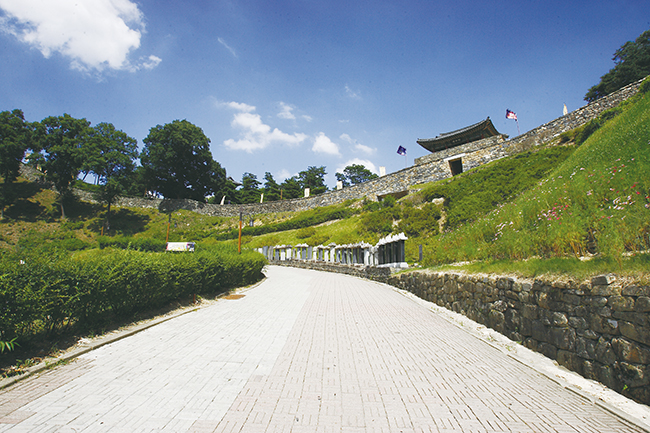
▲ Gongsanseong Fortress
Gongsanseong Fortress, Gongju
Gongsanseong Fortress was built to defend Ungjin (present-day Gongju), which was the capital of Baekje during the period 475-538 CE.
As a natural fort that looks like a folding screen extending from the summit of Gongsan Mountain (height: 110m) to the peaks in the west, it is 2,450m long around the fortress.
At present, Gongsan Mountain is linked to downtown Gongju to the south, facing Geumgang River to the north.
Until the relocation of the capital to Sabi (present-day Buyeo) in 538 CE (16th year of the reign of King Seong), the fortress defended Ungjin, which remained a local administrative center until the Joseon Period (1392-1910). Thus, it is a valuable historic site.
Ancient Tombs in Songsan-ri, Gongju
The Ancient Tombs in Songsan-ri are the seven tombs of kings and members of the royal family of the Baekje Dynasty and are also widely known as the Royal Tomb of King Muryeong.
To their west flows Geumgang River. Gongsanseong Fortress is seen to their east. This group of tombs is divided into two types: brick-built ones and stone-chamber ones made of chipped stones and stones of bizarre shapes.
These types of brick-built tombs appear to have been influenced by those in China. There are clear-cut records as to when the Royal Tomb of King Muryeong was built; thus providing important materials for those studying the social and cultural status of that time.
Archaeological Site in Gwanbuk-ri, Busosanseong Fortress in Buyeo
The Archaeological Site in Gwanbuk-ri in Buyeo is known to be the site of a Royal Palace; it was designated as Chungcheongnam-do Historic Site No. 43 in September 1983.
Where the Royal Palaces of the Baekje and Silla dynasties were exactly remains unknown, but the discovery of parts of the site of Sabi, the last capital of Baekje, has significance for researchers.
Busosanseong Fortress was a defense structure of the Royal Palace of Sabi. Serving as a rear garden of the Royal Palace, it used to be turned into a defense structure in the event of enemy attack.
Many sites of military grain warehouses and buildings have been found within the fortress. Researchers have found that the outlying portion of the walls along the valley was built during the Baekje Period, and that the inner side portion of the walls was constructed during the Unified Silla (668-935 CE) and Joseon (1392-1910) periods.
Ancient Tombs in Neungsan-ri, Buyeo
Ancient Tombs in Neungsan-ri are seven tombs of the Baekje Dynasty. They are located along a road leading to Buyeo. Located near Buyeo, the last capital of Baekje, they are presumed to be royal tombs.
These tombs are stone chambers with stones and earth heaped over them. The brick-built chambers indicate the influence of those of the Southern Dynasties of China, and this fact that shows the brisk exchanges between Baekje and China.
Jeongnimsa Temple Site, Buyeo
As a historic site representing Baekje, it was designated as Historic Site No. 301. The Five-story Stone Pagoda at Jeongnimsa Temple Site was made of granite stone, and it was designated as National Treasure No. 9.
The unique style displayed by each part of the pagoda is regarded as a very important material for those studying the overall styles of stone pagodas on the Korean Peninsula.
The stone pagoda contains inscribed characters about the Baekje Dynasty's fall following the attack of China's Tang Dynasty. It shows that the temple existed as a symbolic space associated with the fate of the Baekje Dynasty.
Naseong City Wall, Buyeo
This was a wall built in the outlying areas of Sabi to defend the capital of Baekje. Surrounding present-day Buyeo-gun, it has been kept in good condition.
At Pilseobong Peak, which is the highest point in nearby areas, the sites of a beacon mound and other relevant facilities remain.
The Royal Palace, government offices, private houses, temples, stores, and defense facilities were presumed to have existed within the castle wall, which also served as the boundary of the capital.
Archeological Site in Wanggung-ri, Iksan
Archeological Site in Wanggung-ri, which is located in Wanggung-myeon, Iksan-si, Jeollabuk-do, was designated as Historic Site No. 408. This site was a separate location built by the Royal Family of Baekje to complement the vulnerability of the capital Sabi. Along with the Mireuksa Temple Site, it is the largest among the historic sites of the Baekje Dynasty.
The site is composed of facilities associated with the Royal Palace as well as workshop facilities making gold and glass objects and temple facilities. The discovery of a large-sized building site provides researchers with information on the structure and layout of the Royal Palace of Baekje.
Mireuksa Temple Site, Iksan
Located on a wide plain near Mireuksan Mountain (height: 430m) in Geumma-myeon, Iksan-si, this site is said to be the largest temple site in East Asia.
The site contains two notable objects: stone pagoda and flagpole supports. Stone Pagoda at Mireuksa Temple Site (National Treasure No. 11; height: 14.24m) is the largest and tallest among the stone pagodas in the country.
Flagpole Supports at Mireuksa Temple Site (Treasure No. 236) are presumed to have been erected before the mid-Unified Silla Period. Each of the 4m tall stone flagpole support making up a set faces the other with a distance of 90cm between them.